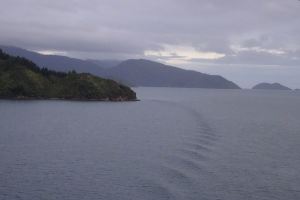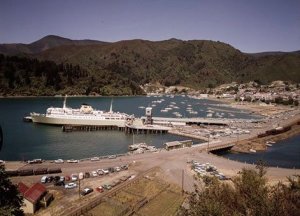
The area on the northern part of the South Island of New Zealand is known as Marlborough Sounds, which consists of a number of ancient, drowned valleys. One of the main bodies of water is called Queen Charlotte Sounds and it is this Sound that we entered to make our way to Picton.

It was just after dawn when we entered Queen Charlotte Sounds so as to make our way to our destination, which was Picton.

The scenery was dramatic, and one had the feeling of being on the only ship in the world.

Suddenly I saw a Cook Is. ferry come from behind an island – we were not alone.
The ferries run a regular service to & from Wellington, which is on the south coast of the North island of New Zealand and Picton is on the northern coast of the South island of New Zealand.
The ferry takes approximately three and a half hours one way, and the ferries carry cars, trucks and rail traffic, as well as passengers.
I have been told that the turnaround of a ferry in Picton is about an hour or so – one deck is dedicated to the rail traffic and road vehicles are able to be driven off by the vehicle’s driver-passenger.
When I mentioned to Will, a long-time friend from HMS Conway, who lives in Wellington, that Maureen & I would be visiting Picton during our cruise he suggested an introduction to his friend Jim, in Picton, who might be able to show us around.
Both Will & Jim are ex Master Mariners and they had been in command of one or more of the ferries during their sea going days.
I jumped at the idea – plus it turned out that Jim grew up in Birkenhead in the UK, the same town in which I lived before I went to HMS Conway.
The last time I visited Picton would have been about 1966 and we loaded frozen lamb for Calcutta.

The above picture is of Picton around 1966.
I was 3rd Mate in Bankura (6793 gt) –
she was a British India Steam Nav. vessel with limited freezer capacity.
 The above picture was taken from our balcony as our cruise ship moved slowly alongside.
The above picture was taken from our balcony as our cruise ship moved slowly alongside.

Once alongside the coaches arrived to operate a regular shuttle service from the ship to the town – the service was very efficient, and I think a shuttle left every ten minutes both to and from the town. The town didn’t look large enough to have so many buses.
Jim & I did not know what each other looked like so after being bussed from the ship to the small-town centre I rang Jim and described myself – the white hair came in handy – and a few minutes later Jim arrived and Maureen and I received the full ‘Cook’s Tour ‘of the area around Picton.


The one thing that was obvious was that the population in Picton loved messing about in boats. Everywhere I looked there were boats of various sizes, from large ocean going motor yachts to small run abouts.

 Beautiful scenery, and perhaps I am stretching a point be referring to the Majestic Princess at 144, 216 GT as a ‘boat’.
Beautiful scenery, and perhaps I am stretching a point be referring to the Majestic Princess at 144, 216 GT as a ‘boat’.


The ferry we saw earlier on her return trip to Wellington.
The site of Picton was surveyed in 1849 and the new town was named Newton, but over the years the town had a number of different names until in 1859 it was renamed Picton in honour of Sir Thomas Picton the hero of Badajoz & Waterloo.

Sir Thomas Picton 1758 -1815
Sir Thomas Picton was born in Haverfordwest in Pembrokeshire, Wales.
He joined the army in 1771 as an ensign and eventually became Lieutenant General.
In 1810 Wellington appointed him to command a division in Spain during the Napoleonic war.
Picton fought in several battles and was wounded at the battle of Badajoz and was sent back home to recuperate.
While in the UK he was Knighted by the Prince Regent George, who later became George IV
Picton was thanked seven times by the British Parliament for his bravery fighting the French.
In 1815, at the Duke of Wellington’s request, Picton was in command of the 5th Infantry Division.
During the Battle of Waterloo Napoleon attacked the British Centre at Le Haye Sainte.
Picton lead his men in a bayonet charge against the French columns to stop the advance. He was shot dead through the temple.
When they checked his body it was realised that General Picton had been wounded in the hip the previous day at the battle of Quatre Bras and had not told anyone other than his servant.
General Picton was the highest ranking allied casualty at Waterloo.

Jack Hawkins portrayed General Picton in the 1970 film called Waterloo.






 At first I thought the building was part of the port authority building until I noticed the name of Hilton, which is not too clear on the photograph taken from the balcony.
At first I thought the building was part of the port authority building until I noticed the name of Hilton, which is not too clear on the photograph taken from the balcony.



















 I watched the above sailing vessel braving the weather as Maureen & I considered a visit to the Vines Bar – which became our favourite.
I watched the above sailing vessel braving the weather as Maureen & I considered a visit to the Vines Bar – which became our favourite.
